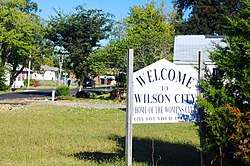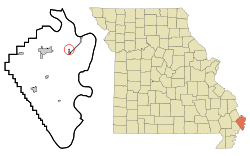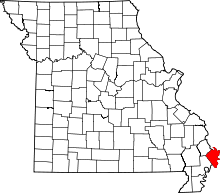Wilson City, Missouri
| Wilson City, Missouri | |
|---|---|
| Village | |
 Wilson City | |
 Location of Wilson City, Missouri | |
| Coordinates: 36°55′23″N 89°13′22″W / 36.92306°N 89.22278°WCoordinates: 36°55′23″N 89°13′22″W / 36.92306°N 89.22278°W | |
| Country | United States |
| State | Missouri |
| County | Mississippi |
| Area[1] | |
| • Total | 0.08 sq mi (0.21 km2) |
| • Land | 0.08 sq mi (0.21 km2) |
| • Water | 0 sq mi (0 km2) |
| Elevation | 315 ft (96 m) |
| Population (2010)[2] | |
| • Total | 115 |
| • Estimate (2016)[3] | 115 |
| • Density | 1,400/sq mi (550/km2) |
| Time zone | UTC-6 (Central (CST)) |
| • Summer (DST) | UTC-5 (CDT) |
| FIPS code | 29-80260[4] |
| GNIS feature ID | 0728967[5] |
Wilson City is a village in Mississippi County, Missouri. The population was 115 at the 2010 census.
History
Wilson City was one of several villages constructed in the early 1940s as part of the "Delmo Project," an initiative by the Farm Security Administration to aid displaced tenant farmers. The village was initially known as "North Wyatt," or the "North Wyatt Group," but had adopted its current name by the late 1960s. The Delmo villages were segregated by race, and Wilson City was one of four Delmo villages designated for African Americans.[6][7]
Geography
Wilson City is located at 36°55′23″N 89°13′22″W / 36.92306°N 89.22278°W (36.923041, -89.222900).[8] The village is situated in northeastern Mississippi County, a few miles southwest of the confluence of the Mississippi River and the Ohio River. The city of Wyatt lies along Missouri Route 77 just south of Wilson City. U.S. Route 62 connects Wilson City with Charleston to the west and Cairo, Illinois, to the northeast.
According to the United States Census Bureau, the village has a total area of 0.08 square miles (0.21 km2), all of it land.[1]
Demographics
| Historical population | |||
|---|---|---|---|
| Census | Pop. | %± | |
| 1960 | 274 | — | |
| 1970 | 295 | 7.7% | |
| 1980 | 309 | 4.7% | |
| 1990 | 210 | −32.0% | |
| 2000 | 165 | −21.4% | |
| 2010 | 115 | −30.3% | |
| Est. 2016 | 115 | [3] | 0.0% |
| U.S. Decennial Census[9] | |||
2010 census
As of the census[2] of 2010, there were 115 people, 56 households, and 25 families residing in the village. The population density was 1,437.5 inhabitants per square mile (555.0/km2). There were 74 housing units at an average density of 925.0 per square mile (357.1/km2). The racial makeup of the village was 2.61% White and 97.39% Black or African American.
There were 56 households of which 19.6% had children under the age of 18 living with them, 5.4% were married couples living together, 30.4% had a female householder with no husband present, 8.9% had a male householder with no wife present, and 55.4% were non-families. 51.8% of all households were made up of individuals and 14.3% had someone living alone who was 65 years of age or older. The average household size was 2.05 and the average family size was 3.08.
The median age in the village was 49.8 years. 19.1% of residents were under the age of 18; 6.1% were between the ages of 18 and 24; 21.8% were from 25 to 44; 33.9% were from 45 to 64; and 19.1% were 65 years of age or older. The gender makeup of the village was 47.8% male and 52.2% female.
2000 census
As of the census[4] of 2000, there were 165 people, 70 households, and 38 families residing in the village. The population density was 2,128.6 people per square mile (796.3/km²). There were 84 housing units at an average density of 1,083.7 per square mile (405.4/km²). The racial makeup of the village was 3.64% White and 96.36% African American.
There were 70 households out of which 24.3% had children under the age of 18 living with them, 18.6% were married couples living together, 25.7% had a female householder with no husband present, and 44.3% were non-families. 34.3% of all households were made up of individuals and 11.4% had someone living alone who was 65 years of age or older. The average household size was 2.36 and the average family size was 2.95.
In the village, the population was spread out with 26.1% under the age of 18, 4.2% from 18 to 24, 27.9% from 25 to 44, 24.8% from 45 to 64, and 17.0% who were 65 years of age or older. The median age was 40 years. For every 100 females, there were 87.5 males. For every 100 females age 18 and over, there were 74.3 males.
The median income for a household in the village was $15,417, and the median income for a family was $23,750. Males had a median income of $35,417 versus $23,000 for females. The per capita income for the village was $11,068. About 37.5% of families and 39.5% of the population were below the poverty line, including 28.8% of those under the age of eighteen and 71.0% of those sixty five or over.
Notable residents
- Romona Robinson (born 1959), Cleveland television news anchor[10]
References
- 1 2 "US Gazetteer files 2010". United States Census Bureau. Retrieved 2012-07-08.
- 1 2 "American FactFinder". United States Census Bureau. Retrieved 2012-07-08.
- 1 2 "Population and Housing Unit Estimates". Retrieved June 9, 2017.
- 1 2 "American FactFinder". United States Census Bureau. Retrieved 2008-01-31.
- ↑ "US Board on Geographic Names". United States Geological Survey. 2007-10-25. Retrieved 2008-01-31.
- ↑ Steve Mitchell, "Homeless, Homeless are we...," Preservation Issues, Vol. 3, No. 1 (1993).
- ↑ Michael J. Meyer, "An Evaluation of the North Lilbourn Group, Delmo Farm Labor Homes Project, On Route D in New Madrid County, Missouri," Missouri Department of Transportation, 2001, p. 16.
- ↑ "US Gazetteer files: 2010, 2000, and 1990". United States Census Bureau. 2011-02-12. Retrieved 2011-04-23.
- ↑ "Census of Population and Housing". Census.gov. Retrieved June 4, 2015.
- ↑ Washington, Julie (7 December 2011). "Robinson timeline". Cleveland Plain Dealer. Retrieved 13 January 2016.
